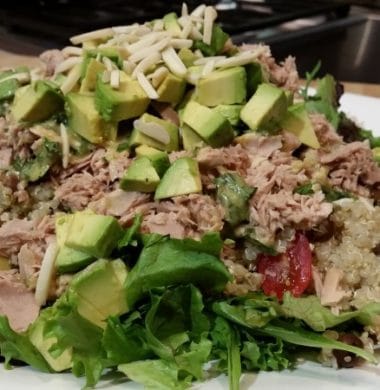Quinoa Avocado Fava Bean Tuna Salad with Honey Lime Dressing Recipe

Richard E. Collins, MD, THE COOKING CARDIOLOGIST®
Quinoa, pronounced keen-wa, is a wholesome easy-to-prepare whole grain. Think slow carbs rather than no carbs. Not all carbohydrates are bad. In fact, they are needed in the body for energy and the brain. Here is a whole grain high protein salad perfect for spring with the tuna. The fava beans are great for brain health providing L-dopa, an essential neurotransmitter.
- 2 cups cooked quinoa
- 1 cup cooked fava beans (use frozen peeled fava beans) or canned, rinsed and drained fava beans or substitute frozen, thawed lima beans
- 1 cup cherry tomatoes, halved
- 1 bunch green onions, chopped
- 2 cups watercress greens
- 1 T chopped fresh thyme
- 1 T chopped fresh basil
- 1 T chopped fresh Italian parsley
- 1 T fresh squeezed lime juice
- Zest of 1 lime (use the lime from the juiced lime)
- 2 T honey
- 2 T Dijon mustard
- 1 T extra virgin olive oil
- Fresh ground pepper to taste
- 1 large 10-ounce large can of light cooked tuna in water or two 4.5-ounces of water packed tuna
- 1 fresh avocado peeled, seeded and chopped
- ¼ cup almonds, slivered
1) Prepare rinsed quinoa according to package directions. 1 cup dry equals 2 cups cooked. The water to quinoa ratio is usually 2 parts liquid to one part quinoa. Cook, cool and place in a large bowl. Cook the fava beans according to package instructions. Cool and add the beans, tomatoes, and green onions to the quinoa.
2) For the dressing, in a small bowl, whisk the herbs, zest, lime juice, honey, mustard and olive oil. Toss ½ of the dressing with the quinoa ingredients. Chill for 1 hour.
3) Plate up 6 dishes with watercress greens and top with the equally divided quinoa. Top with the tuna and the avocado. Drizzle remaining dressing over the top and garnish with the slivered almonds.
Serves 6. Serving size: 1/6 of recipe with watercress salad greens and tuna.
Nutrition Info: Calories: 300, Total Fat: 11 g, Saturated Fat: 1.5g, Trans Fat: 0g, Cholesterol: 15 mg, Sodium: 160 mg, Carbohydrate: 31 g, Fiber: 7 g, Protein: 20 g
Diabetic Exchanges: 1 ½ Carbohydrates, 3 Very Lean Protein, 1 Fat
- Lifestyle Changes That Can Help Manage Arrhythmia - April 30, 2025
- Common Treatments for Peripheral Vascular Disease - April 23, 2025
- Are Ultra-Processed Foods Bad for Your Heart Health? - April 14, 2025
Sign Up
As with any health concerns, your specific treatment program should be discussed thoroughly with your primary care physician as well as any specialists who may need to be consulted – like a cardiologist.
Sign Up
